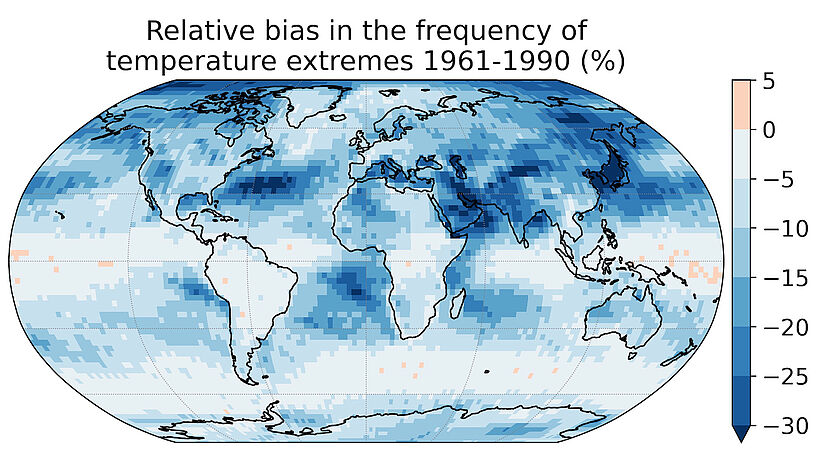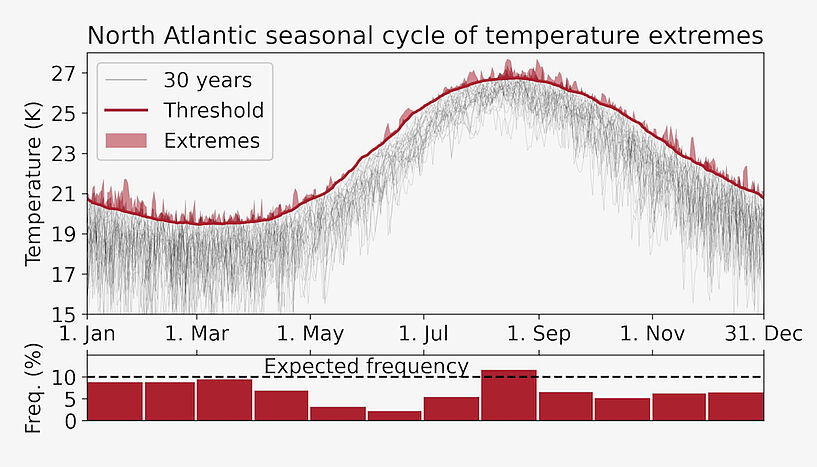Frequency of heat days systematically underestimated in many studies
19. March 2024Error in established calculation method discovered
Many studies on the climate crisis focus on researching temperature extremes on a global scale. Scientists at the University of Vienna have now uncovered an error in an established calculation method, leading to a systematic underestimation in the frequency of heat days. The error is based in the previously unnoticed impact of the seasonal cycle on the extreme threshold due to the incorrect application of so called "moving time windows". The study has recently been published in the journal Nature Communications.
Increasingly frequent temperature extremes are one of the most dangerous consequences of human-induced climate change and, as such, the subject of numerous scientific analyses. A commonly used method to define extremes such as heat days takes the adaptation to local conditions into account and calculates them relative to the local temperature distribution. However, researchers from the Department of Meteorology and Geophysics at the University of Vienna have now identified a significant error in the calculation of such relative extremes.
Temperature extremes are often defined relative to local conditions to encompass unusually hot periods worldwide. This approach uses different threshold values, for example, for Europe and Antarctica, allowing for a comparison in the occurrence of heat days between these climatically diverse regions. In the calculation of the local temperature threshold, so-called moving time windows are often employed. These windows aim to increase the number of days considered for threshold calculation, intending to enhance the meaningfulness of the threshold. Many previous studies have, therefore, increased the length of this time window from the originally recommended 5 days to up to 31 days. The newly published study now demonstrates that such long time windows lead to a mixing of the seasonal cycle into the threshold, inadvertently reducing the probability of extremes.
The calculation error can, depending on the region, lead to an underestimation of the expected heat day frequency, as explained by the lead author of the study, Lukas Brunner, Senior Scientist at the Department of Meteorology and Geophysics at the University of Vienna: "Heat days are often defined as the 10 percent warmest days at each location. However, we were able to show that an error in the calculation can lead to a considerable underestimation in the number of extreme days. This has been overlooked in many studies so far." Regions particularly affected include the western United States and the Arabian Peninsula, where only 7 percent heat days are detected by the algorithm instead of the correct 10 percent, leading to a relative error of -30 percent. In contrast, the probability of heat days in Europe is quite accurately estimated at the correct 10 percent. "These regional differences in the manifestation of the error we have identified can distort the interpretation of results and lead to issues when comparing different regions of the world," explains Brunner.
Global warming reduces the error
The study also examines the impact of climate change, revealing that with unabated emissions, certain regions will experience almost continuous temperature extremes in the future. The discovered underestimation of extremes decreases with extreme climate warming. However, this leads to an overestimation of the change signal, as climate scientist Brunner explains: "By the end of the century, in hotspot regions like the Arabian Peninsula, almost every day will be considered a heat day by today's standards. But due to the error the historical period has only 7 percent heat days instead of the correct 10 percent, leading to an overestimation in the increase."
In their study, the authors also propose a correction that almost entirely eliminates the error. "We hope that our study leads to future work avoiding the error, allowing for a better characterization of changes in temperature extremes within the framework of climate change," says Aiko Voigt, co-author of the study and Professor at the Department of Meteorology and Geophysics at the University of Vienna.
Original publication in Nature Communications:
Lukas Brunner, Aiko Voigt: Pitfalls in diagnosing temperature extremes. 2024.
DOI: 10.1038/s41467-024-46349-x
Picture:
Fig. 1: The study shows that heat days are underestimated by up to 30 per cent on average over 30 years if the error is not corrected - in other words, only 70 per cent of the actual temperature extremes are detected in some regions. CC BY: Lukas Brunner
Fig. 2: The impact of the error varies greatly from region to region - the effects are particularly clear in the North Atlantic: In June, for example, the frequency of hot days was underestimated by more than 75 per cent, resulting in only a quarter of the actual extremes being detected. Averaged over the year, the temperature extremes were also significantly below the expected frequency. CC BY: Lukas Brunner
Scientific contact
Dr. Lukas Brunner
Institut für Meteorologie und GeophysikUniversität Wien
1090 - Wien, Josef-Holaubek-Platz 2 (UZA II)
+43-(0)1-4277-53743
l.brunner@univie.ac.at
Univ.-Prof. Dr. Aiko Voigt
Institut für Meteorologie und Geophysik1090 - Wien, Josef-Holaubek-Platz 2 (UZA II)
+43-1-4277-53740
aiko.voigt@univie.ac.at
Further inquiry
Theresa Bittermann
Media Relations, Universität Wien1010 - Wien, Universitätsring 1
+43-1-4277-17541
theresa.bittermann@univie.ac.at
Downloads:
20240318_BrunnerVoigtEN_Pic2.jpg
File size: 535,67 KB
20240318_BrunnerVoigtEN_Pic1.jpg
File size: 582,33 KB


